Aquarium plants certainly do better with Co2, but not every plant needs it. That’s because each plant has a different energy, i.e., high and low energy.
High energy aquatic plants are dependent on Co2, fertilizer, and strong water movement. But low energy plants can survive in slow water changes and less fertilizers.
Aquatic plants that don’t need Co2 are also the first choice of beginners because they eliminate purchasing an expensive Co2 system.
A thing here to note about these plants is that they have slow to moderate growth speed. That’s because Co2 speeds up growth. And since they don’t need it, they need time. Thus, give the plant enough time to grow and avoid disturbing it.
As aquatic plants that don’t need Co2 are gaining popularity, several options have been discovered. But our absolute favorite is the Java Fern. It looks great and offers a natural-like feel to the fish tank.
Not to mention, Java Fern also has low maintenance requirements. That means you can grow it in the tank without any worry. Besides this plant, the post also features a few other aquatic plants that can easily survive without C02. You can also check out 10 best freshwater aquatic plants for beginners.
Table of Contents
Plants That Don’t Need co2 – Top 12 Plants
Some aquarium plants don’t need CO2 to survive. Here’s the list:
- Java Fern
- Anubias
- Cryptocoryne
- Amazon Swords
- Vallisneria
- Wisteria
- Pennywort
- Duckweed
- Hygrophila
- Fontinalis Moss
- Dwarf Sagittaria
- Hornwort
List of Easy Aquarium Plants that Don’t Need Co2
The below-mentioned plants look stunning and have basic requirements, which makes them so popular. Whether you are a beginner or an expert tank keeper, these plants will impress you.
A thing to note here is that while these plants do not need Co2, they surely have certain requirements. So, it’s your responsibility to fulfill those needs. Otherwise, your plant will get dull and die.
#1 Java Fern
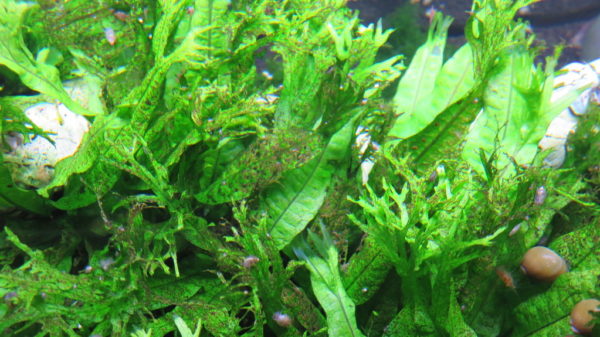
If you are a beginner, Java Fern is right for you because it can be easily managed. Ideally, it grows in shady areas. That’s why it does not have high lighting needs. So, even if you keep it in normal lighting condition in your tank, it will survive.
If you want your Java Fern to grow into a beautiful green plant, consider tying it to a rock. That’s because this plant does not do well in buried sand as its root cannot extract essential nutrients.
It’s a slow-growing plant that offers enough space to fish for hiding. It propagates by growing tiny plants, which further fall off. If your Java Fern grows bigger than required, you can trim it.
Java Fern’s scientific name is Microsorium Pteropus.
| Maintenance | Low |
| Temperature | 68 – 84F |
| pH | 6 – 7 |
| Size | 13.5 inches |
| Fertilizer | No |
| Lighting | Low lighting |
It’s a sturdy plant that is capable of adapting itself to any living condition. If you are impressed with its specifications, don’t forget to grow it in the tank.
#2 Anubias

Next on this list is the Anubias that also does not require much maintenance. The best thing about this plant is that it can easily grow on various surfaces like gravel, sand, pebbles, and rocks.
These plants come from West and Central Africa. Also, it’s generally found near streams and rivers. While burying the plant, you should avoid buying its rhizomes. That’s because then the plant will not grow properly.
You can easily recognize this plant with its dark green and sturdy leaves. Its leaves come in different shapes and sizes, making it one of the most beautiful aquatic plants. If you are planting Anubias in the tank, give it time to grow.
| Maintenance | Low |
| Temperature | 62 – 82F |
| pH | 6.5 – 7.5 |
| Size | 12 inches |
| Fertilizer | No |
| Lighting | Low to moderate lighting |
While this plant grows slowly, it becomes fluffy. It further enhances the beauty of the fish tank.
#3 Cryptocoryne
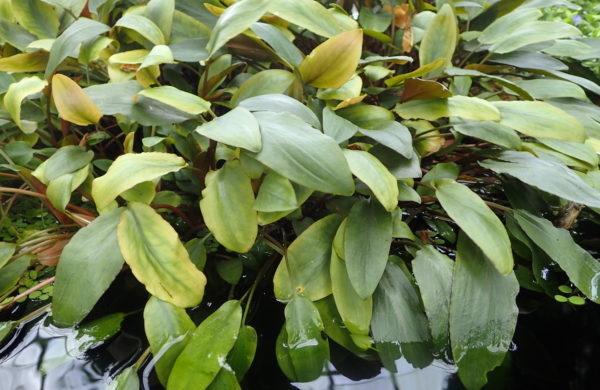
Cryptocoryne is one of the best aquatic plants because it can survive a great deal of abuse. It looks great and does not turn the talk into a mini jungle even if not offered regular trim. Like Anubias, it can also grow on different surfaces, like pebbles, rocks, sand, and gravel.
Getting this plant for your fish tank will be one of your best decisions because fish can also eat it. That means Cryptocoryne not only decorates the tank and offers fish a better place to hide, but it helps in survival.
If you don’t want the fish to eat this plant, try to fill the aquarium with small fish. That’s because only big fish can eat it. But fish can’t uproot this plant because its roots are strong and tightly held on the surface it’s attached to.
| Maintenance | Low |
| Temperature | 68 – 82F |
| pH | 6 – 7.5 |
| Size | <6 inches |
| Fertilizer | Yes, root tabs |
| Lighting | Low lighting |
It’s a root-feed plant that requires root tabs for better growth. But it doesn’t need any other kind of fertilizer.
#4 Amazon Swords
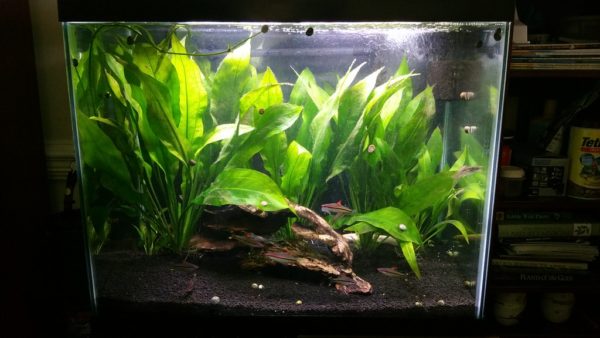
It’s also a popular aquatic plant that people like growing in their fish tanks. The best thing about this plant is that it is perfect for beginners and experts as it doesn’t require much maintenance.
Amazon Sword can make a great background plant because it can grow tall. The plant can reach a height that can perfectly cover the filter and heater installed at the back of the tank.
If you are growing this plant, you must offer it root tabs as it is an excessive root feeder plant. If the lighting condition is low, it will take time to grow.
Amazon Sword’s scientific name is Echinodorus grisebachii.
| Maintenance | Medium |
| Temperature | 72 – 82F |
| pH | 6.5 – 7.5 |
| Size | 20 inches |
| Fertilizer | Yes, root tabs |
| Lighting | Moderate lighting |
If you want to purchase an Amazon Sword for a small aquarium, you should go for the dwarf version.
#5 Vallisneria
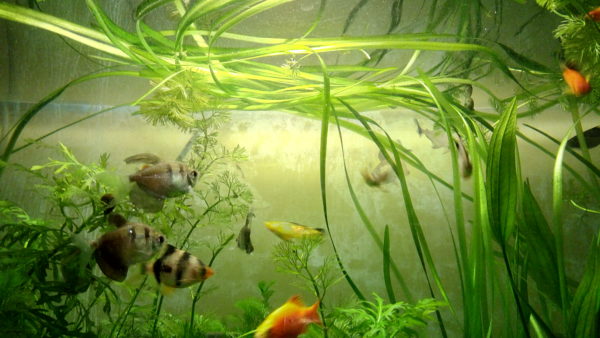
Another easiest aquarium plant is the Vallisneria. This one grows as a long vertical backdrop, which looks great and gives the tank a natural-like feel. Also, when it is placed in a group, it offers fish enough space for hiding.
While this plant is not as easily managed as Java Fern or Anubias, you can make it survive with proper care and effort. It needs fertilizers to have a better-growing speed. But if you can’t find any specific fertilizer, you can also add root tabs.
Vallisneria propagates by shoots that move along the gravel, which is called runners. This thing helps the plant create a jungle-like atmosphere in the tank.
| Maintenance | Medium |
| Temperature | 63 – 82F |
| pH | 6.5 – 8.5 |
| Size | 20 inches |
| Fertilizer | Yes, root tabs |
| Lighting | Moderate lighting |
Whether you have a big or small aquarium, you can consider growing this plant. Once it spreads and becomes lush, your fish can weave in and out of the long leaves.
#6 Wisteria
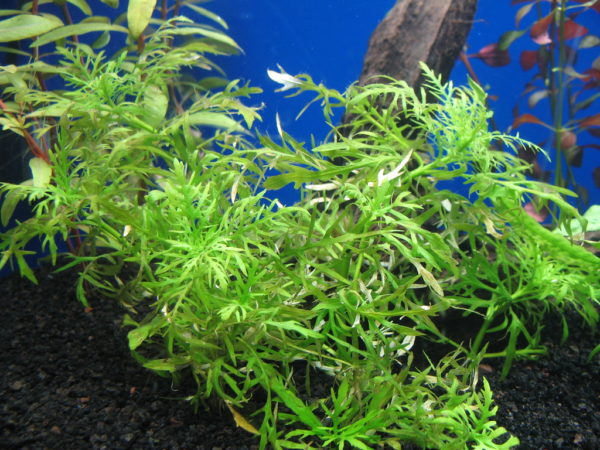
An aquatic plant that can be easily grown in the fish tank without much of an effort is Wisteria. It’s very sturdy and hard, which makes it the right choice for beginners. You can either grow a few Wisteria plants in the tank or plant them in bunches to make an excellent background.
The best thing about this plant is that it can survive in any condition. Also, it does not have many requirements. It can handle any level of abuse, but make sure that it’s not under shade.
Since it’s a tall plant, you are advised to grow it in a large aquarium only. But if you want to keep it in a small aquarium, offer it frequent trims.
| Maintenance | Low |
| Temperature | 70 – 82F |
| pH | 6.5 – 8 |
| Size | 20 inches |
| Fertilizer | Yes, root tabs |
| Lighting | Low to moderate lighting |
When placing it in a sand substrate, remember attaching it to an anchor. This way, the plant will not float on the fish tank water surface.
#7 Pennywort
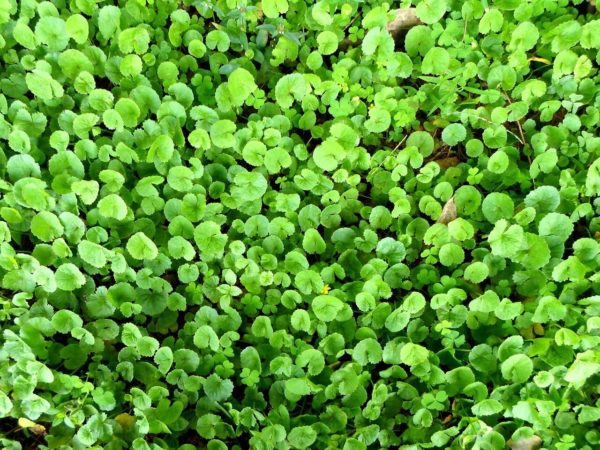
If you want a plant that grows quickly even without using Co2, Pennywort should be your pick. This beautiful plant is demanding, which makes it a perfect choice for every tank keeper.
Talking about light requirements, this fast-growing plant needs high light. If you offer it the kind of light it needs, the plant will become an adult in no time. You can either bury it in the sand or let it float on the tank water surface.
By growing this plant in your tank, you can add a dash of tropical touch to the background. Tetra and rainbow fish are great companions for this plant.
Pennywort’s scientific name is Hydrocotyle leucocephala.
| Maintenance | Low |
| Temperature | 68 – 82F |
| pH | 6 – 7.8 |
| Size | 8 inches |
| Fertilizer | Yes |
| Lighting | Moderate lighting |
While Pennywort is a fast-growing plant, add nitrogen as a supplement if you want to increase its speed further.
#8 Duckweed
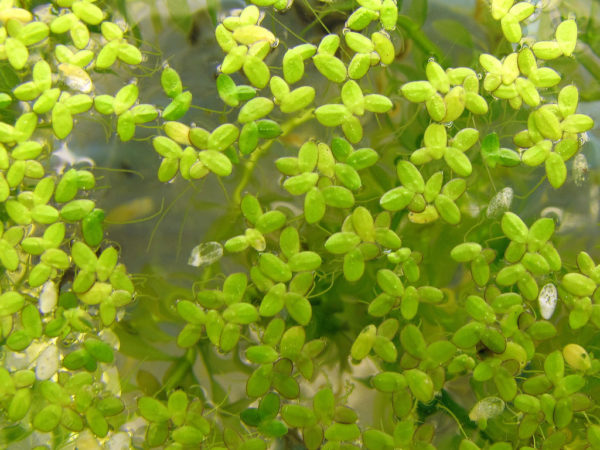
Duckweed is a floating plant gaining huge popularity among tank keepers because it’s under demanding requirements. This plant is so low-maintenance that it’s considered very beginner-friendly.
It floats just beneath the surface, forming a lush green carpet on the top surface. Duckweed provides shade and shelter to fish from harsh light and plants.
An interesting thing about this plant is its flowering ability. In fact, Duckweed is one of the smallest aquatic plants that are capable of flowering. You can see the flowers under the microscope.
Not to mention, this aquatic plant also acts as a purifier that provides good nutrients to the tank water. Since it grows quickly, it’s essential to control the spread. If not done, it can quickly take over the surface.
Duckweed’s scientific name is Lemnoideae.
| Maintenance | Low |
| Temperature | 48.2 – 91F |
| pH | 5 – 9 |
| Size | Each pod is around 0.8 inches |
| Fertilizer | No |
| Lighting | Low to high lighting |
Duckweed forms a protective layer on the top, but it can also cause low oxygen levels. Thus, you need to keep an eye on it.
#9 Hygrophila
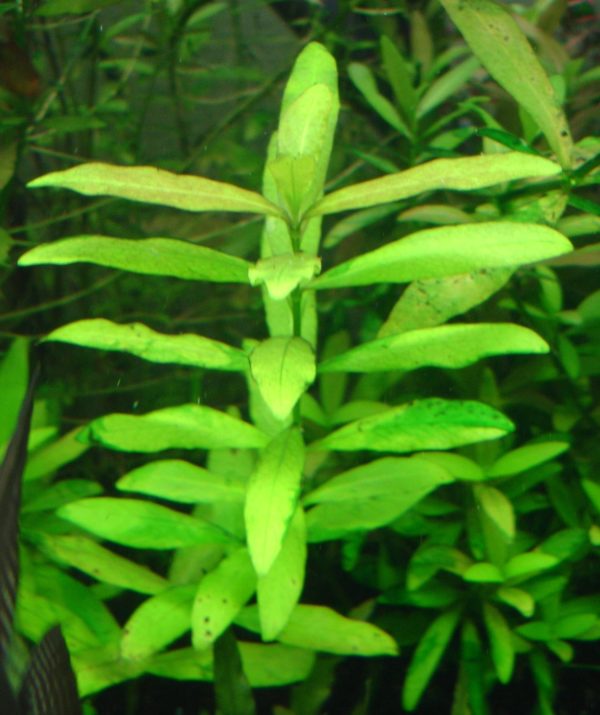
Another plant that can tolerate heavy abuse is the Hygrophila. This thing makes it ideal for beginners and experts. This plant is not just popular, but it’s also very common and can be quickly found.
Hygrophila are also known for their easy and quick propagating. That means you don’t have to invest in so many plant stems. Talking about the light requirement, it can survive in any lighting condition.
It’s advised to grow this plant on a nutrient-rich substrate. This way, Hygrophila will have healthy and better growth. Also, it’s a fast-growing plant. That means you need to trim it now and then.
| Maintenance | Low |
| Temperature | 70 – 82F |
| pH | 6.5 – 7.5 |
| Size | 20 inches |
| Fertilizer | Yes, you can |
| Lighting | Moderate to high lighting |
The flowers of Hygrophila grow very quickly. Also, under normal circumstances, this plant has wavy green leaves.
#10 Fontinalis Moss
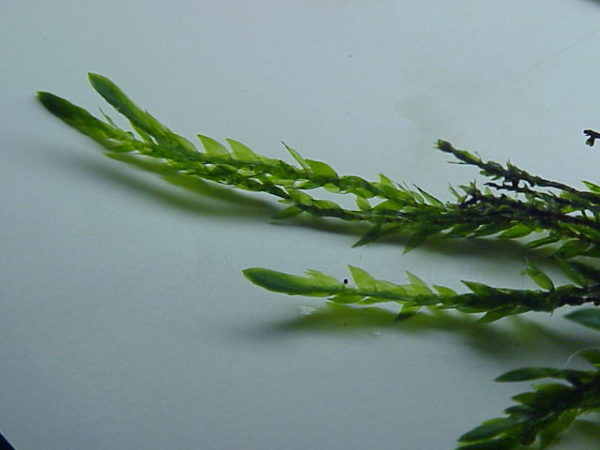
If you are looking for an aquatic plant that looks like moss, then Fontinalis Moss should be your pick. This unique-looking plant can either be placed in the background or foreground.
Tank keepers like Fontinalis Moss because its thick leaves offer a better hiding place to the fish. Under the thick leaves, fish can even lay eggs.
In addition, Fontinalis Moss can survive a variety of living conditions. Ideally, it is kept in cold water along with goldfish.
| Maintenance | Low |
| Temperature | 70 – 82F |
| pH | 5.5 – 7.5 |
| Size | 24 inches |
| Fertilizer | Yes, you can |
| Lighting | Low to medium lighting |
Fontinalis Moss is a great choice for a fish tank, which you cannot afford to miss. Also, you can offer it fertilizer to speed up its growth rate.
#11 Dwarf Sagittaria
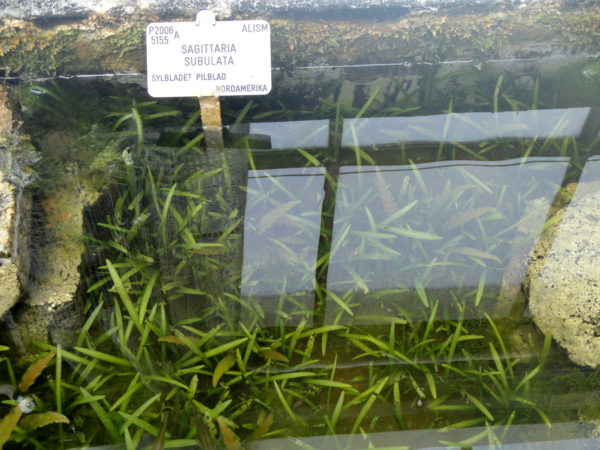
Another aquarium plant on this list is the Dwarf Sagittaria. Tank keepers like it because it has a wide range of tolerating power. That means it’s ideal for beginners.
Also, this plant does not have much growth requirement. But one thing that you need to consider while growing Dwarf Sagittaria is its lighting requirement. The distance of this plant from the light source has a great impact on its growth.
While this plant does not need Co2, you can add nitrate to speed up its growth rate.
| Maintenance | Low |
| Temperature | 68 – 82F |
| pH | 6 – 8 |
| Size | 12 inches |
| Fertilizer | Yes, you can |
| Lighting | Medium lighting |
This plant can be kept in normal lighting conditions. Since it’s a dwarf version, it does not grow too big, making it ideal for small and big tanks.
#12 Hornwort
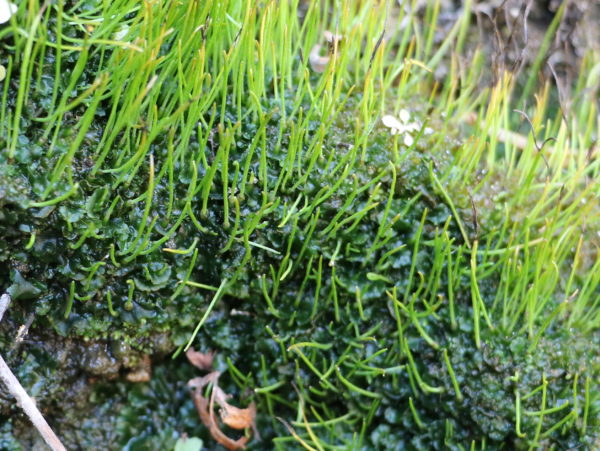
The last aquatic plant on this list is the Hornwort. Just like others, this one also has a high tolerance level. It is mostly planted in the background. But you can let it float on the water’s surface.
This plant does not have roots, but you can use its leaves to anchor the plant. For the anchor, tie the leaves to a piece of wood.
When you are placing this plant in the tank, you must remember that it has allelopathy abilities. That means it can absorb the nutrients of other plants for its growth. So, you should avoid growing any other plant with Hornwort.
| Maintenance | Low |
| Temperature | 59 – 86F |
| pH | 6 – 7.5 |
| Size | 10 inches |
| Fertilizer | No |
| Lighting | Medium lighting |
Hornwort is ideal for small tanks because you won’t have to fill the space by growing other kinds of aquatic plants.
Summary
Aquarium plants that do not need Co2 are ideal because they do not require you to invest in any expensive system. These plants are self-sufficient, and they can extract nutrients from the tank water.
One thing that needs to be considered is that these plants have a slow growth rate. So, if you want your plant to have a better growth rate, you must add certain kinds of fertilizer. Adding fertilizers will also make their leaves green and keep them happy.
Besides the recommended options, you can even consider other plants. Whatever aquatic plant you choose for your tank, always check its pH level, lighting requirements, and other essential factors.
No related posts.
